|
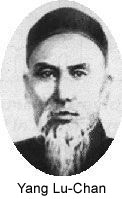 Tai Chi Chuan originates in the Chen village (Chenjiagou) in Henan
province in China but it was an outsider to the village, Yang Lu-Chan
(1799-1872), who first made it famous. Yang Lu-Chan, who became known
as 'Yang the invincible', brought the art from rural obscurity into the
public-eye in the 19th Century. Tai Chi Chuan originates in the Chen village (Chenjiagou) in Henan
province in China but it was an outsider to the village, Yang Lu-Chan
(1799-1872), who first made it famous. Yang Lu-Chan, who became known
as 'Yang the invincible', brought the art from rural obscurity into the
public-eye in the 19th Century.
Yang Lu-Chan had trained in the Chen village for a good number of years
(estimates vary wildly from 9 to 40 years) before returning to his home
in Yongnian and later moving to Beijing. In Beijing he came to the attention
of the Emperor. He was reputed to have trained the Emperor's bodyguards
and members of the royal household, which indicates the respect with which
his art was held, and he defeated all challengers, earning his ‘invincible’
nickname. At this time Tai Chi Chuan, (then known as 'Long Boxing' or
'Cotton Fist'), was known first and foremost as an effective fighting
art. By all accounts the martial aspects were retained by Yang Lu-Chan's
two sons who followed in their father's footsteps and taught Tai Chi Chuan
(Yang Ban-Hou and Yang Chien-Hou) after his death. |
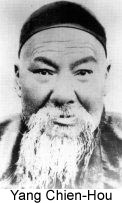 The third son of Yang Lu-Chan, Yang Chien-Hou (1839-1917)
was credited with creating and practicing the 'middle frame' of the Yang
style. His elder brother Yang Ban-Hou practiced 'small frame' and had
a much more aggressive temperament, thus keeping few students. Yang Chien-Hou
was more popular, since he wasn't as harsh in his training methods as
his brother, but compared to his son Yang Cheng-Fu, who popularised Tai
Chi Chuan throughout China when he standardised the movement into the
'large frame' Form, he still had very few students.
The third son of Yang Lu-Chan, Yang Chien-Hou (1839-1917)
was credited with creating and practicing the 'middle frame' of the Yang
style. His elder brother Yang Ban-Hou practiced 'small frame' and had
a much more aggressive temperament, thus keeping few students. Yang Chien-Hou
was more popular, since he wasn't as harsh in his training methods as
his brother, but compared to his son Yang Cheng-Fu, who popularised Tai
Chi Chuan throughout China when he standardised the movement into the
'large frame' Form, he still had very few students.
One of Yang Chien-Hou's students was General Li Jing-Lin.
Li Jing-Lin was a renowned warrior and almost without equal when it came
to fighting with sword or spear. Li Jing-Lin was introduced to Yang Chien-Hou
and they had a friendly contest using the Chinese straight sword, which
Yang Chien-Hou won easily. As Yang Chien-Hou was the only person able
to defeat General Li Jing-Lin with a sword, General Li immediately asked
to become his student. |
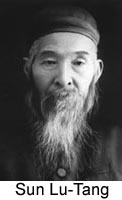 Sun Lu-Tang 1861 - 1933 was an innovative martial artist and learned
his arts from a variety of renowned sources. He began his martial arts
training by learning Shaolin Hung boxing and then began to study Hsing-I,
first from Li Kui-Yuan and later from the famous Gou Yun-Shen. He learned
Pa Qua from Cheng Ting-Hua, a direct student of the founder Dong Hai-Chuan
and later began studying Wu style Tai Chi Chuan with Hao Wei-Chen, founder
of little Wu or Hao style, before creating his renowned Sun style Tai
Chi Chuan which, understandably, incorporates elements of the different
influences on his martial arts.
Sun Lu-Tang 1861 - 1933 was an innovative martial artist and learned
his arts from a variety of renowned sources. He began his martial arts
training by learning Shaolin Hung boxing and then began to study Hsing-I,
first from Li Kui-Yuan and later from the famous Gou Yun-Shen. He learned
Pa Qua from Cheng Ting-Hua, a direct student of the founder Dong Hai-Chuan
and later began studying Wu style Tai Chi Chuan with Hao Wei-Chen, founder
of little Wu or Hao style, before creating his renowned Sun style Tai
Chi Chuan which, understandably, incorporates elements of the different
influences on his martial arts.
To Some extent Sun Lu-Tang's style brings together the three main schools
of Internal boxing - Hsing-I, Tai Chi Chuan and Pa Qua Chuan. Sun Lu-Tang
was a teacher of Ku Yue-Chang. |
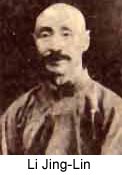 General Li Jing-Lin (1885 - 1931) was a very high ranking government
official. Along with General Chang Chih-Chiang, he decided that the two
most important styles of Chinese Martial Arts were Shaolin and Wu Tang
and thus these were the styles to be taught in the government schools
by the Five Tigers. He was renowned for his swordsmanship. He studied
martial arts with Sun Lu-Tang, was a contemporary of Yang Cheng-Fu but
learned his Tai Chi Chuan from Cheng-Fu's father Yang Chien-Hou. It is
often speculated that his straight sword form was the one that was incorporated
into the Yang family tradition, rather than it being of Chen family origin.
His 'Wu Tang sword' style is very rare these days, probably due to its
reputed complexity. General Li Jing-Lin was a teacher of Ku Yue-Chang.
General Li Jing-Lin (1885 - 1931) was a very high ranking government
official. Along with General Chang Chih-Chiang, he decided that the two
most important styles of Chinese Martial Arts were Shaolin and Wu Tang
and thus these were the styles to be taught in the government schools
by the Five Tigers. He was renowned for his swordsmanship. He studied
martial arts with Sun Lu-Tang, was a contemporary of Yang Cheng-Fu but
learned his Tai Chi Chuan from Cheng-Fu's father Yang Chien-Hou. It is
often speculated that his straight sword form was the one that was incorporated
into the Yang family tradition, rather than it being of Chen family origin.
His 'Wu Tang sword' style is very rare these days, probably due to its
reputed complexity. General Li Jing-Lin was a teacher of Ku Yue-Chang.
|
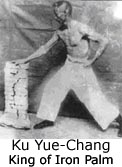 The picture shows Ku Yue-Chang demonstrating his famous Iron Palm by
breaking a stack of bricks with a single palm strike. Notice that there
are no spacers between the bricks. This is tremendous feat, which probably
hasn’t been replicated since. (CLick the picture to see a larger
image.)
The picture shows Ku Yue-Chang demonstrating his famous Iron Palm by
breaking a stack of bricks with a single palm strike. Notice that there
are no spacers between the bricks. This is tremendous feat, which probably
hasn’t been replicated since. (CLick the picture to see a larger
image.)
Ku Yue-Chang was a very famous Chinese martial artist who's first teachers
were Yim Kai-Wun and his father Ku Lei-Chi. He gained the nickname “King
of Iron Palm” for his famous iron palm skills, and was placed as
one of the winners in the 1928 First National Wushu Contest, held in Nanjing.
(There seems to be no common agreement about who won this particular competition,
since it was stopped before the closing matches were played out due to
excessive injuries. In short, it was just too dangerous. Therefore the
last contestants remaining were all declared winners.) Though best known
as a Northern Shaolin stylist (and for his amazing Iron Palm) Ku Yue-Chang
was expert in the internal arts as well and it is from him that our Tai
Chi Chuan descends.
After the competition Ku Yue-Chang was appointed as one of 'the Five
Tigers of the North', he, with the other four masters - Won Lai-Shen (Pa
Qua), Fu Chan-Song (Li Far Spear), Wong Shao-Chu and Li Shan-Wu (Tan Tui),
were to open National Martial Art Schools and teach Chinese Martial Arts
to the masses. One of the main objectives of the government, during the
1920's, was to unify China. They developed a motto: "A Strong Mind
in a Strong Body builds a Strong Country". Part of their plan was
to use martial arts to strengthen the populace. When Ku Yue-Chang's moved
to the republican capital of Nanjing it is interesting to note that he
left his provincial school in Guangzhou (Kwangchou) to Lau Kam-Tang (Liu
Ching-Tang), a famous Choy Lee-Fut master.
It was in a highly charged political environment, that Ku Yue-Chang developed
his knowledge and skills. This must have been a very exciting time for
this young teacher with exceptional skill. At this time, Ku Yue-Chang
would have been 34 years old. Young indeed for a martial arts master at
that time, younger still to be named a National Instructor. Ku Yue-Chang
studied other styles during this period. These include the internal styles
of Hsing-I, Pa Qua and Tai Chi Chuan with Sun Lu-Tang. He also had important
exchanges with Tan Sam, founder of Bak Hsing Choy Lee Fut and one of the
five southern tigers. In fact, they reportedly had a match in which no
one is certain of the true victor. What is certain, though, is that the
Choy Lee Fut lineage of Tan Sam incorporated Northern Shaolin sets in
its curriculum and Ku Yue-Chang's school taught Choy Lee Fut. Indeed,
Ku Yue-Chang and Tan Sam exchanged students and Lung Tse-Cheung was sent
to Tan Sam's school to learn the art. Lung Tse-Cheung spent several years
learning from Tan Sam before returning to Ku Yue-Chang.
Ku Yue-Chang also learned Wutang sword style from Li Jing-Lin, and more
Cha quan with Yu Zhensheng. He also reportedly shared teaching responsibilities
at the Zhongyang Association with a famous Muslim boxer called Wang Ziping
(1881-1973), who was an expert in Tan Tui and Cha quan.
Finally it is also interesting to note that the Northern Shaolin sets
that are preserved in the Choy Lee Fut branches of Tan Sam are preformed
with a horizontal fist as in Cha quan, but that the forms, taught to Kim
Sheung-Mo, a disciple of Ku Yue-Chang, are preformed with a standing fist
much like Beng quan (wood) of Hsing-I quan, but not as bent at the elbow.
Ku Yue-Chang trained in seven different martial arts including: Beishaolin
taught to him by Yin Kai-Wun, Cha quan, taught to him by his father and
Zhensheng, Hsing-I and Pa Qua Chang, taught to him by Sun Lu-Tang, as
well as Tai Chi Chuan (taught to him by Li Jing-Lin and Sun Lu-Tang),
Baji and Wu Tang Sword taught to him by Li Jing-Lin."
Early in 1952 Ku Yue-Chang advised Kim Sheung-Mo and Lung Tse-Chung to
flee the Chinese mainland and set up a school in Hong Kong, which they
did. It is thought that Ku Yue-Chang himself was executed as a counter
revolutionary by the communist authorities later in 1952, probably because
of his martial arts status and his strong nationalist beliefs. Many martial
arts figures met the same fate during this period of China's history. |
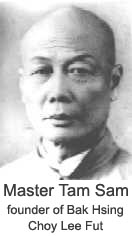 Choy Lee Fut originated from the Shaolin system and was created as
an individual style by Chan Heung, who learned his art from three masters:
Chan Yuen-Wu, Lee Yau-Shan and the monk Choy Fook. Chan Heung called
his art Choy Lee Fut to commemorate his teachers and the Buddhist origin
of the art (Fut means Buddha in Cantonese) and it is commonly known as
Hung Hsing Choy Lee Fut.
Choy Lee Fut originated from the Shaolin system and was created as
an individual style by Chan Heung, who learned his art from three masters:
Chan Yuen-Wu, Lee Yau-Shan and the monk Choy Fook. Chan Heung called
his art Choy Lee Fut to commemorate his teachers and the Buddhist origin
of the art (Fut means Buddha in Cantonese) and it is commonly known as
Hung Hsing Choy Lee Fut.
The particular style of Choy Lee Fut practiced in Yongquan classes is
known as Bak Hsing, or Northern style, Choy Lee Fut. Although primarily
thought of as a Southern art, Tan San, the Bak Hsing founder, taught
out of Siu Bak in the Northern province of Guangzhou.
Tan San was an accomplished boxer before he came to study Choy Lee Fut
but after a 'friendly' match with a Hung Hsing Choy Lee Fut practitioner,
in which Tan San was clearly beaten, he decided to study under the victor's
master, Liu Chan. Tan San trained for many years but he was something
of an innovator and went on to modify the teachings of his master to
the point where he had created a radically different approach to the
application of Choy Lee Fut technique. |
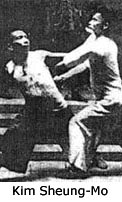 Kim Sheung-Mo was, by all accounts, a quiet man. He was a disciple
of the famous Ku Yue-Chang, but never bragged about being the student
of such a famous teacher.
Kim Sheung-Mo was, by all accounts, a quiet man. He was a disciple
of the famous Ku Yue-Chang, but never bragged about being the student
of such a famous teacher.
Of the two famous disciples of Ku Yue-Chang who taught Lam Kam-Chuen,
Kim Sheung-Mo and Lung Tse-Chung, Kim Sheung-Mo was the older, being closer
to the age of Ku Yue-Chang, and a good 20 years older than Lung Tse-Chung.
It is said that Kim Sheung-Mo's style remained closer to that of Ku Yue-Chang,
while Lung Tse-Chung's differed slightly because he was swapped as an
exchange student with Tan Sam.
Kim Sheung-Mo is seen in the picture to the left performing the Northern
Shaolin two man Form that we still practice today. (Click on the picture
to see a larger image.)
What can be said for certain is that the 'old Yang' Form we practice
in the YMAA is the one taught by Kim Sheung-Mo. As luck would have it
another student of Kim Sheung-Mo (Chan Kwok-Kai) moved to South America
and set up a Kung Fu school there. As you would expect he's known mainly
for his Northern Shaolin, but pictures of him doing Tai Chi Chuan and
a short video clip of some of his students demonstrating the Form (downloaded
from a site linked to their Web site) reveal that they practice the same
Long Form that we do, with only minor differences. Their Form still has the same characteristic diagonal NE and NW angles
for the opening moves, instead of the more common N, then E then W directions
of the Yang Cheng-Fu Form. |
| 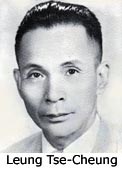 Lung Tse-Cheung was a student of Ku Yue-Chang who was sent by master
Ku to learn Bak Hsing Choy Lee Fut from master Tan Sam. Lung Tse-Cheung
was a fellow student of Kim Sheung-Mo, though he was some twenty years
his junior, and was joint teacher, along with Kim Sheung-Mo, of Lam
Kam-Chuen, specifically teaching Choy Lee Fut to the young master Lam
but also sharing the teaching of Tai Chi Chuan and other arts, including
Iron Palm and Iron shirt (Golden Bell) Chi Kung.
Lung Tse-Cheung was a student of Ku Yue-Chang who was sent by master
Ku to learn Bak Hsing Choy Lee Fut from master Tan Sam. Lung Tse-Cheung
was a fellow student of Kim Sheung-Mo, though he was some twenty years
his junior, and was joint teacher, along with Kim Sheung-Mo, of Lam
Kam-Chuen, specifically teaching Choy Lee Fut to the young master Lam
but also sharing the teaching of Tai Chi Chuan and other arts, including
Iron Palm and Iron shirt (Golden Bell) Chi Kung.
|
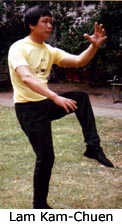 Lam Kam-Chuen was born in Hong Kong just after the second world war
and began training at the age of 11, in Hsing-I, with Master Fung who
was 80 at that time. he then went on to study Northern Shaolin, Choy Lee
Fut and Tai Chi Chuan with Kim Sheung-Mo and Lung Tse-Cheung. His teachers
also included the venerable Yun Hang, Chueh Wan (Tung Bei boxing) and
Lau Sau-Hong, who first introduced him to I-Chuan and Zhan Zhong.
Lam Kam-Chuen was born in Hong Kong just after the second world war
and began training at the age of 11, in Hsing-I, with Master Fung who
was 80 at that time. he then went on to study Northern Shaolin, Choy Lee
Fut and Tai Chi Chuan with Kim Sheung-Mo and Lung Tse-Cheung. His teachers
also included the venerable Yun Hang, Chueh Wan (Tung Bei boxing) and
Lau Sau-Hong, who first introduced him to I-Chuan and Zhan Zhong.
Later master Lam was able to meet and study with the famous I-Chuan (Da
Cheng Chuan) master Professor Yu Yong-Nian, who studied directly under
the founder of the style - Grand Master Wang Xiang-Zhai. Master Lam is
now the European representative of the Da Cheng Chuan tradition.
The picture shows Master Lam performing the Tai Chi Chuan posture known
as Golden Cock Stands on One Leg.
Master Lam studied old style combat Tai Chi Chuan, Iron Palm, I Chuan,
Choy Lee Fut, Northern Shao Lin, Nei Kung, traditional Chinese weapons
and much more. Master Lam was a martial arts instructor to the Royal Hong
Kong Police and is qualified in Traditional Chinese Medicine, specialising
in bone setting, herbalism and the use of Chi and Chi Kung to cure ailments.
Master Lam came to England in 1975 and began teaching both privately and
for the ILEA (thanks to the help of a Yoga teacher named Beryl Heed who
became one of his first students). In 1977 he opened his first clinic
in this country and began to practice as a Chinese doctor. In the late
seventies master Lam developed his own 'short Form' which cuts the number
of movents from 128 to 60 and balances the postures on the right and left
sides, his Form, however, manages to retain the flavour and martial characteristics
of the original long Form.
Gradually a small group of private students developed and in 1982 Master
Lam founded the Lam Tai Chi Association to help spread Tai Chi Chuan and
related arts. Master Lam is an expert in Zhan Zhong (Jam Jong- to stand
like a tree) Chi Kung and in 1995 made a 5 part documentary for Channel
Four TV called Stand Still be Fit. Master Lam has published books on Zhan
Zhong Chi Kung, his own Short Form and Feng Shui, on which he is also
a leading authority. |
 Raymond Rand began training in the Chinese Martial Arts, primarily:
Tai Chi Chuan, Nei Kung and Choy Lee Fut (Bak Hsing) in January 1976,
with Lam Kam-Chuen. Prior to this he had three years experience in Ten
Shin Shinyo Ryu (Ju Jitsu) and some six months in Wing Chung.
Raymond Rand began training in the Chinese Martial Arts, primarily:
Tai Chi Chuan, Nei Kung and Choy Lee Fut (Bak Hsing) in January 1976,
with Lam Kam-Chuen. Prior to this he had three years experience in Ten
Shin Shinyo Ryu (Ju Jitsu) and some six months in Wing Chung.
Sifu Rand started the first class at Middlesex University in June 1983
at the request of his teacher, Master Lam, and was a founder member, and
first chairman, of the Lam Tai Chi Association which started in 1982.
In 1994 Sifu Rand founded the Middlesex University Students Tai Chi Chuan
Association, in recognition of the growing number of students at Middlesex
University and the need for his own senior students to have a recognised
platform from which to grow.
Also in 1994 links were forged with Sifu Yeung Loon Fong (Sifu Peter
Young) through the yearly Internal Arts Competitions and Masters Demonstrations
he held in Newcastle, UK. A team from Middlesex University demonstrated
at the Masters event on two occasions and Sifu Rand and his seniors were
invited to judge at the Competition yearly from 1994 until it ceased to
be held.
In the year 2000 the Middlesex Tai Chi Chuan Association became the
Yongquan Tai Chi Chuan Association, to reflect the fact that most of
our classes now take place off Middlesex University campus (though we
still retain strong links with Middlesex University) and has since become
the Yongquan Martial Arts Association reflecting the martial emphasis
of both our Tai Chi Chuan and the other arts studied, such as Choy Lee
Fut.
In 2005 the YMAA joined forces with a Hsing-I school and
and a further exchange of ideas and principles took place under the YMAA banner. |

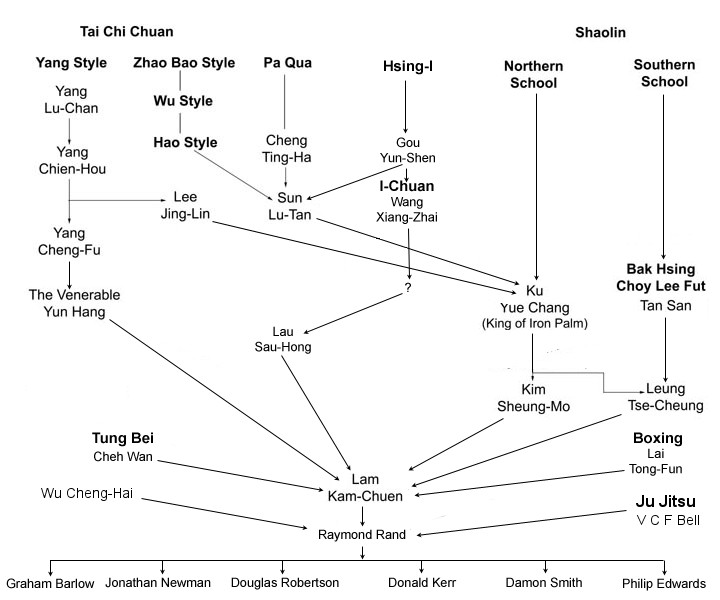


 Tai Chi Chuan originates in the Chen village (Chenjiagou) in Henan
province in China but it was an outsider to the village, Yang Lu-Chan
(1799-1872), who first made it famous. Yang Lu-Chan, who became known
as 'Yang the invincible', brought the art from rural obscurity into the
public-eye in the 19th Century.
Tai Chi Chuan originates in the Chen village (Chenjiagou) in Henan
province in China but it was an outsider to the village, Yang Lu-Chan
(1799-1872), who first made it famous. Yang Lu-Chan, who became known
as 'Yang the invincible', brought the art from rural obscurity into the
public-eye in the 19th Century. The third son of Yang Lu-Chan, Yang Chien-Hou (1839-1917)
was credited with creating and practicing the 'middle frame' of the Yang
style. His elder brother Yang Ban-Hou practiced 'small frame' and had
a much more aggressive temperament, thus keeping few students. Yang Chien-Hou
was more popular, since he wasn't as harsh in his training methods as
his brother, but compared to his son Yang Cheng-Fu, who popularised Tai
Chi Chuan throughout China when he standardised the movement into the
'large frame' Form, he still had very few students.
The third son of Yang Lu-Chan, Yang Chien-Hou (1839-1917)
was credited with creating and practicing the 'middle frame' of the Yang
style. His elder brother Yang Ban-Hou practiced 'small frame' and had
a much more aggressive temperament, thus keeping few students. Yang Chien-Hou
was more popular, since he wasn't as harsh in his training methods as
his brother, but compared to his son Yang Cheng-Fu, who popularised Tai
Chi Chuan throughout China when he standardised the movement into the
'large frame' Form, he still had very few students. Sun Lu-Tang 1861 - 1933 was an innovative martial artist and learned
his arts from a variety of renowned sources. He began his martial arts
training by learning Shaolin Hung boxing and then began to study Hsing-I,
first from Li Kui-Yuan and later from the famous Gou Yun-Shen. He learned
Pa Qua from Cheng Ting-Hua, a direct student of the founder Dong Hai-Chuan
and later began studying Wu style Tai Chi Chuan with Hao Wei-Chen, founder
of little Wu or Hao style, before creating his renowned Sun style Tai
Chi Chuan which, understandably, incorporates elements of the different
influences on his martial arts.
Sun Lu-Tang 1861 - 1933 was an innovative martial artist and learned
his arts from a variety of renowned sources. He began his martial arts
training by learning Shaolin Hung boxing and then began to study Hsing-I,
first from Li Kui-Yuan and later from the famous Gou Yun-Shen. He learned
Pa Qua from Cheng Ting-Hua, a direct student of the founder Dong Hai-Chuan
and later began studying Wu style Tai Chi Chuan with Hao Wei-Chen, founder
of little Wu or Hao style, before creating his renowned Sun style Tai
Chi Chuan which, understandably, incorporates elements of the different
influences on his martial arts. General Li Jing-Lin (1885 - 1931) was a very high ranking government
official. Along with General Chang Chih-Chiang, he decided that the two
most important styles of Chinese Martial Arts were Shaolin and Wu Tang
and thus these were the styles to be taught in the government schools
by the Five Tigers. He was renowned for his swordsmanship. He studied
martial arts with Sun Lu-Tang, was a contemporary of Yang Cheng-Fu but
learned his Tai Chi Chuan from Cheng-Fu's father Yang Chien-Hou. It is
often speculated that his straight sword form was the one that was incorporated
into the Yang family tradition, rather than it being of Chen family origin.
His 'Wu Tang sword' style is very rare these days, probably due to its
reputed complexity. General Li Jing-Lin was a teacher of Ku Yue-Chang.
General Li Jing-Lin (1885 - 1931) was a very high ranking government
official. Along with General Chang Chih-Chiang, he decided that the two
most important styles of Chinese Martial Arts were Shaolin and Wu Tang
and thus these were the styles to be taught in the government schools
by the Five Tigers. He was renowned for his swordsmanship. He studied
martial arts with Sun Lu-Tang, was a contemporary of Yang Cheng-Fu but
learned his Tai Chi Chuan from Cheng-Fu's father Yang Chien-Hou. It is
often speculated that his straight sword form was the one that was incorporated
into the Yang family tradition, rather than it being of Chen family origin.
His 'Wu Tang sword' style is very rare these days, probably due to its
reputed complexity. General Li Jing-Lin was a teacher of Ku Yue-Chang.
 Choy Lee Fut originated from the Shaolin system and was created as
an individual style by Chan Heung, who learned his art from three masters:
Chan Yuen-Wu, Lee Yau-Shan and the monk Choy Fook. Chan Heung called
his art Choy Lee Fut to commemorate his teachers and the Buddhist origin
of the art (Fut means Buddha in Cantonese) and it is commonly known as
Hung Hsing Choy Lee Fut.
Choy Lee Fut originated from the Shaolin system and was created as
an individual style by Chan Heung, who learned his art from three masters:
Chan Yuen-Wu, Lee Yau-Shan and the monk Choy Fook. Chan Heung called
his art Choy Lee Fut to commemorate his teachers and the Buddhist origin
of the art (Fut means Buddha in Cantonese) and it is commonly known as
Hung Hsing Choy Lee Fut.
 Lung Tse-Cheung was a student of Ku Yue-Chang who was sent by master
Ku to learn Bak Hsing Choy Lee Fut from master Tan Sam. Lung Tse-Cheung
was a fellow student of Kim Sheung-Mo, though he was some twenty years
his junior, and was joint teacher, along with Kim Sheung-Mo, of Lam
Kam-Chuen, specifically teaching Choy Lee Fut to the young master Lam
but also sharing the teaching of Tai Chi Chuan and other arts, including
Iron Palm and Iron shirt (Golden Bell) Chi Kung.
Lung Tse-Cheung was a student of Ku Yue-Chang who was sent by master
Ku to learn Bak Hsing Choy Lee Fut from master Tan Sam. Lung Tse-Cheung
was a fellow student of Kim Sheung-Mo, though he was some twenty years
his junior, and was joint teacher, along with Kim Sheung-Mo, of Lam
Kam-Chuen, specifically teaching Choy Lee Fut to the young master Lam
but also sharing the teaching of Tai Chi Chuan and other arts, including
Iron Palm and Iron shirt (Golden Bell) Chi Kung. Lam Kam-Chuen was born in Hong Kong just after the second world war
and began training at the age of 11, in Hsing-I, with Master Fung who
was 80 at that time. he then went on to study Northern Shaolin, Choy Lee
Fut and Tai Chi Chuan with Kim Sheung-Mo and Lung Tse-Cheung. His teachers
also included the venerable Yun Hang, Chueh Wan (Tung Bei boxing) and
Lau Sau-Hong, who first introduced him to I-Chuan and Zhan Zhong.
Lam Kam-Chuen was born in Hong Kong just after the second world war
and began training at the age of 11, in Hsing-I, with Master Fung who
was 80 at that time. he then went on to study Northern Shaolin, Choy Lee
Fut and Tai Chi Chuan with Kim Sheung-Mo and Lung Tse-Cheung. His teachers
also included the venerable Yun Hang, Chueh Wan (Tung Bei boxing) and
Lau Sau-Hong, who first introduced him to I-Chuan and Zhan Zhong. Raymond Rand began training in the Chinese Martial Arts, primarily:
Tai Chi Chuan, Nei Kung and Choy Lee Fut (Bak Hsing) in January 1976,
with Lam Kam-Chuen. Prior to this he had three years experience in Ten
Shin Shinyo Ryu (Ju Jitsu) and some six months in Wing Chung.
Raymond Rand began training in the Chinese Martial Arts, primarily:
Tai Chi Chuan, Nei Kung and Choy Lee Fut (Bak Hsing) in January 1976,
with Lam Kam-Chuen. Prior to this he had three years experience in Ten
Shin Shinyo Ryu (Ju Jitsu) and some six months in Wing Chung.